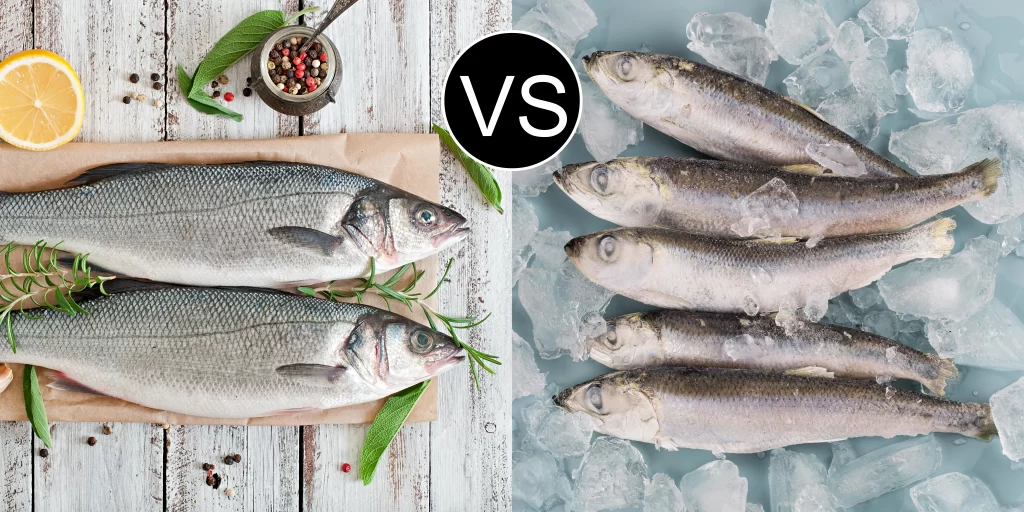When it comes to purchasing seafood, fresh fish remains fresh and rich in nutrients. It is also perfect with texture and taste. Moreover, the debate of fresh fish vs. frozen fish remains the same.
To others, there simply isn’t a comparison to create regarding the freshness and flavor of fresh fish. Does absolutely fresh-sea-caught fish impress so much more? Here, in this article, we explore the delicacies of freshness for favorites red snapper and mahi mahi.
Moreover, in this guide, we will compare fresh fish quality and frozen flavors of fish so that buyers can make a wise decision and choose the best. We will contrast fresh fish quality and flavor with frozen fish so that you can make your best-informed choices for the next seafood meal.
Understanding Fish Freshness
You have to understand what “fresh” actually means while buying seafood. Fish mongers catch the fish and place them in the market to sell it.
Whereas frozen fish is caught and frozen as soon as possible to preserve its freshness. Freezing can make fish last longer on the shelf, but freshness, flavor, and texture are far from the same.
The Freshness Factor
Freshness is responsible for the flavor, texture, and nutritional value of the fish. Fresh fish is soft and moist with no taste. Fresh fish would usually be easily recognizable by pale, shiny skin, bulging eyes, and a fresh sea-like smell. Frozen fish will lose these characteristics to some degree. Freezing changes, the texture and, if done badly, a drier product result.
So, let’s get up close and personal with finned favorites such as mahi mahhi and red snapper to learn the differences between fresh vs. frozen.
1. Mahi Mahi: Taste and Quality
Fresh Mahi Mahi
Mahi Mahi, a dolphin fish, is a tropical delight with a subtle flavor and firm texture. Fresh mahi mahi is light reddish-pink and has a beautiful, delicate flavor that will hold up to a great variety of dishes, ranging from grilling to frying.
Flavor: Fresh mahi mahi is juicy, moist, and flaky, with a flavor best used in tacos or as a substitute for citrus sauce. The sweetness is expressed and the bite is great.
Texture: Fresh mahi mahi is firm in texture and juicy. It flakes nicely without breaking apart and retains a good grill.
Quality: It does not exist for frozen mahi mahi. Freezing will retain much of the flavor and texture but nowhere close to that of fresh.
Frozen Mahi Mahi
Flavor: The frozen mahi mahi will be fishy or tasteless from freezer burn or poor storage. If you bought good quality frozen mahi mahi, however, the flavor can be good enough to cook.
Texture: The thawed and refrozen mahi mahi will be dry and mushy, particularly.
2. Red Snapper: Quality and Taste
Fresh Red Snapper
Fresh, soft, and juicy red snapper with its delicate flavor is savored in most of the preparation. Snowy and white in flesh and bright and pink colored, it is a delight to watch and to eat.
Flavor: Snapper red fresh is a fragile, sweet fish with a bold flavor that will harmonize well with most herbs, spices, and sauces. Snapper fresh, grilled, pan-fried, or baked will make your dish reach the pinnacle of flavor.
Texture: The fresh red snapper is not hard but is firm, and it retains shape when cooked. It flakes well and is, therefore, an excellent fish to use in just about any preparation.
Frozen Red Snapper
Frozen red snapper is acceptable if the fresh cannot readily be obtained. Even that then becomes a matter of storage and freezer.
Flavor: Frozen red snapper will probably not be as nice as fresh and too fishy tastes sometimes, depending on how long frozen. When using frozen snapper, use flash-frozen for a taste closer to the real thing.
Texture: The texture of frozen red snapper will become soggy unless well handled. Properly handled, it will also remain firm in texture, though less pleasing to the eye than when fresh fish is used.
Fresh vs. Frozen: Key Differences
Flavor
Fresh fish will taste less fishy and have a richer flavor than frozen fish. Freshness brings out the natural flavors of the fish, and that is always a better choice to consume. Fresh mahi mahi, for instance, has that sweetness that brings richness to the dish, but frozen might lack that bite. Fresh fish tastes less fishy because it is freshly caught from the boat, with that ocean-fresh taste that most seafood lovers love.
Texture
It is something you feel when you eat it. The fresh fish is firm in texture and juicy. This is especially so when cooking it; you have those nice flakes and soft bites. The frozen fish loses water when it freezes, and the texture is not as good. When not thawed well, it becomes mushy, and this does not suit sensitive palates.
Nutritional Quality
Frozen or fresh fish is fine, but fresh fish is best. Fresh fish retains its nutritional content, i.e., omega-3 fatty acids, the most critical ones for heart health. Nutrients are lost during freezing fish, particularly when fish has been in the frozen state for a longer period. Flash-frozen quality fish is still safe to consume for one’s nutrition.
Convenience
Frozen fish is also extremely convenient. You can fill your freezer with whatever fish you like, so you have seafood at hand to use whenever you want. This is especially handy for busy lifestyles. Fresh fish, although generally better in taste, is more hassle to organize. You will need to buy it nearer the time that you will be eating it, as it does not store so well.
Best Fish Buying Practices
Regardless of whether you buy fresh or frozen, use the following advice when buying fish:
Choose Quality: Buy fish with bright, clear eyes and wet, shiny flesh. Fresh fish should not have a strong smell.
Ask Questions: Don’t be afraid to ask your fishmonger where the fish was caught and when it was collected. Good staff will be able to provide the freshest catch.
Choose Sustainable: If possible, try to choose fish that are sustainably caught. This is less damaging to the environment and is usually of higher quality.
Know Your Sources: When frozen fish, try to choose manufacturers that are known for quality processing. Flash-freezing directly from the catch is theoretically able to preserve the flavor and texture better than older methods.
Conclusion
To the frozen variety, fresh fish such as mahi mahi and red snapper are evidence that the newer product is better in taste, texture, and quality. Frozen fish is easy to prepare and healthy, but it can’t compare to the excitement of preparing and eating fresh fish directly from the seas.
For those who are ready to go the extra mile for a new experience, the payoff is a dish that gets better with each bite. But when you’re in a rut, using good-quality frozen fish can be a treat to your dinner, too. Choose according to availability, craving, and affection for the sea!
Unimitra Seafood is the right place to purchase high-quality seafood for your perfect dinner options.




